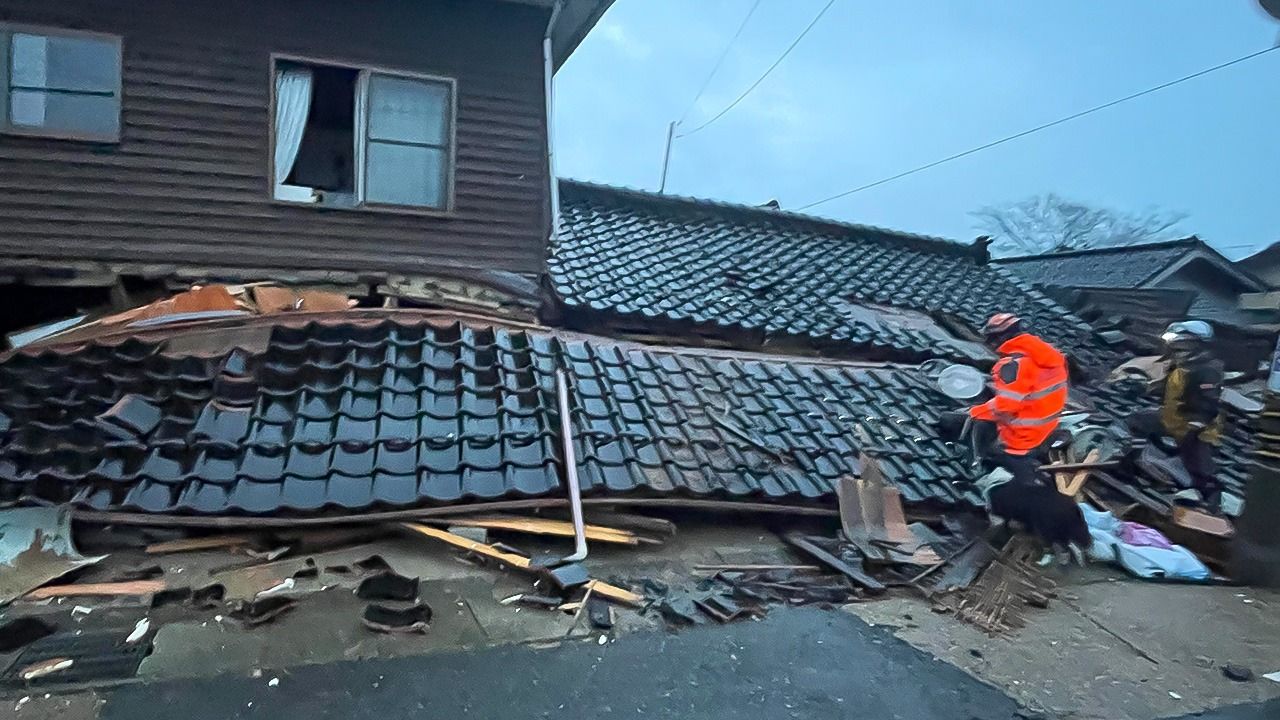
Not Much Time: My Mission to Find Earthquake Survivors
Disaster Society- English
- 日本語
- 简体字
- 繁體字
- Français
- Español
- العربية
- Русский
New Year’s Day Earthquake
At around 3:00 pm on January 3, we were driving near Wajima, on the Noto Peninsula in Ishikawa Prefecture, when the white SUV in the opposing lane suddenly swerved in front of us, blocking the road. The driver got out and blurted out nervously, “The road has been blocked by a landslide. I’ve just seen it for myself. Go back.”

The author had to take a detour through private property to avoid these cracks in the road. (Courtesy JRDA Team 7)
Two days after the first quake, our squad, all members of the Japan Rescue Dog Association (Nihon Kyūjoken Kyōkai), had exited the expressway at Kanazawa, Ishikawa; we were making our way toward Wajima. We wondered if the aftershocks on the morning of January 3 had caused the weakened ground to collapse—there was no telling what kind of secondary hazards we might now face. The incident reminded us of the harsh reality of working in disaster zones.
I have been a member of the JRDA for 10 years now. Along with my fellow volunteers, I have trained my dog, Coco, to be a search and rescue dog. The JRDA has two dog teams: Team 7, which uses a training ground in Chiba that it leases from the Ichikawa municipal government, and Team Sakura, which is based in Machida, Tokyo. I am a member of Team 7, which I am involved in running. I am also the deputy head of the JRDA’s search and rescue dog division.
Team 7 comprises nearly 30 volunteers from all walks of life, including professionals, entrepreneurs, and housewives, and they range in age from under 30 to over 70. Over half of the team are women. These volunteers act as dog handlers, training their own dogs to perform search and rescue tasks. After our dogs have mastered basic commands such as “stay” and “come,” we train them to search for survivors trapped under rubble and collapsed buildings.
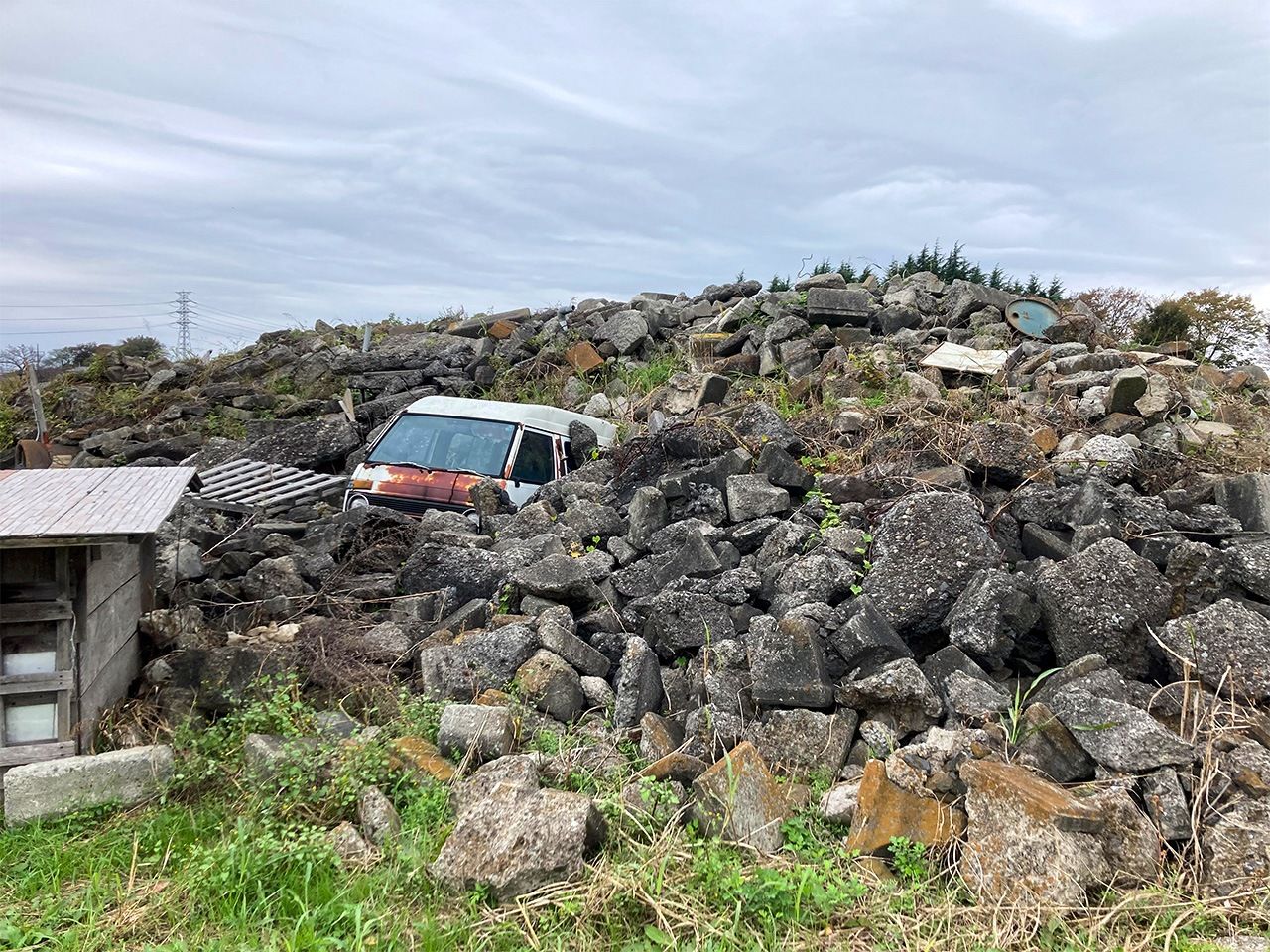
The JRDA training ground in Fujimi. (Courtesy JRDA Team 7)
The earthquake struck the Noto peninsula at 4:10 pm on New Year’s Day. Having an uneasy feeling that I might be called up, I followed the TV and online coverage intently. The members of our squad had standing orders to stand by in our homes in the event of an earthquake measuring six or above on Japan’s seismic intensity scale.
Thirty minutes after the earthquake struck, I was received instructions from the JRDA to round up the members of Team 7. I forwarded the message to the rest of the team, and asked for volunteers to go to the disaster site. Ultimately, four volunteers from Team 7 went to the disaster area, while an additional three handlers, including the squad leader, and their three dogs remained on standby.
A rear support group was also formed within Team 7. Their job was sharing useful traffic and weather information with those on the ground. Meanwhile, those on standby in their homes were constantly updated on the location and status of the team on the ground. Those of us in the field also used Line messaging groups to keep their families constantly updated so they would not worry. Thanks to the rear support team, were were able to work on site with peace of mind.
On the afternoon of January 2, we agreed to meet at 6:00 am the following morning at Nagano Prefecture’s Lake Suwa rest area on the Chūō Expressway, before heading north to the city of Suzu.
Volunteers in my organization are generally required to organize and pay for their own accommodation and meals—the organization only reimburses their transport. Noto lacked power and water, and shops were closed, making it impossible to procure supplies locally. I packed 12 liters of water, instant noodles, tinned food, and boil-in-the-bag meals, as well as a camping pot and a portable burner. I also had a teammate bring gasoline in a jerrycan. Because we would have to sleep in our cars, I packed a thick sleeping bag and body warmers as well.
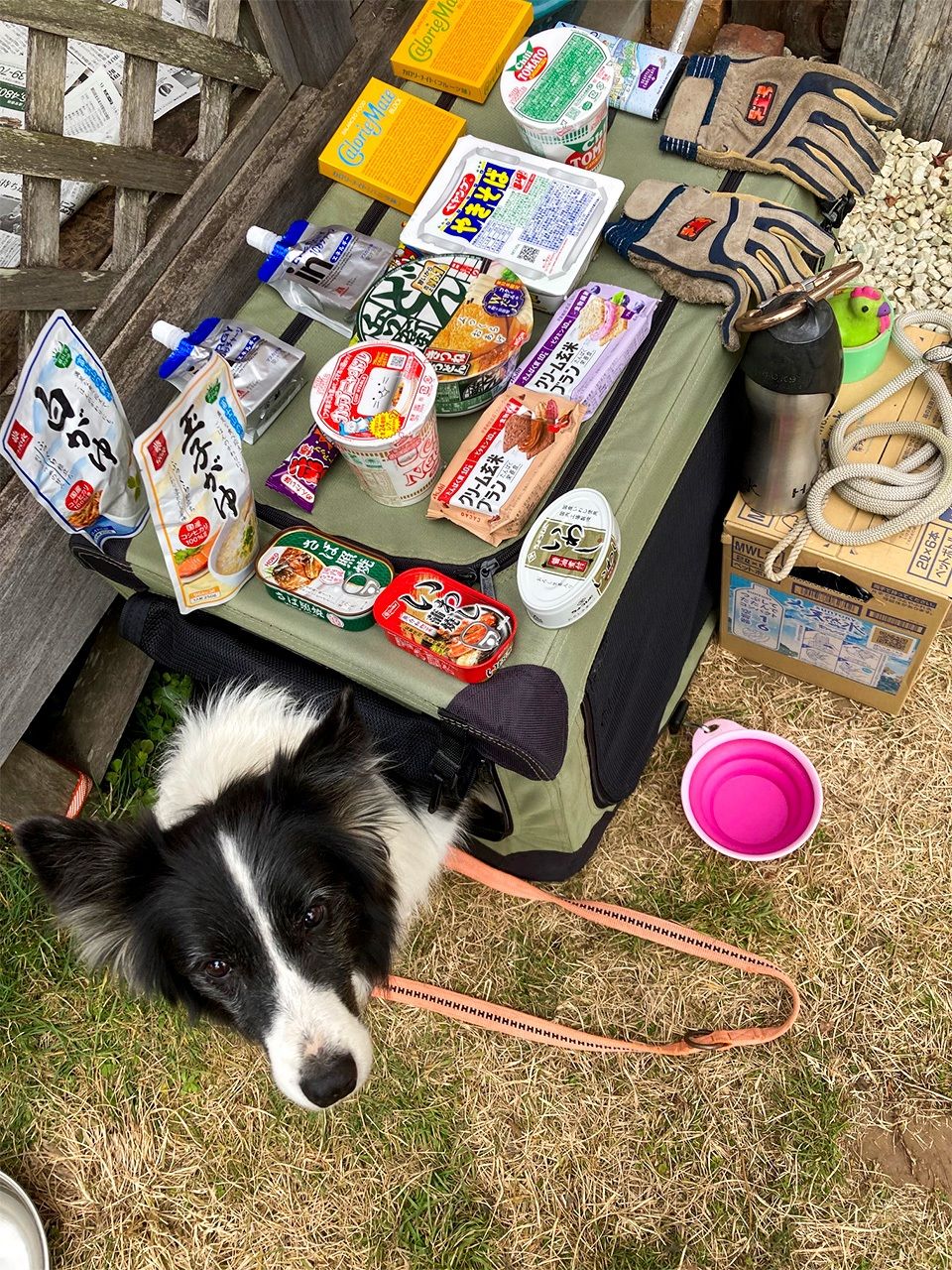
The food I took with me. (Courtesy JRDA Team 7)
I also packed four days’ of dog food, as well as water, snacks, balls, other toys, a thick mat, and pet waste bags and sheets. Suzu is a long way off, so both handlers and their dogs would need to take many breaks and toilet stops along the way. In addition to individual gear, our team also packed walkie-talkies, climbing ropes, and whiteboards.
Earthquake Doubles Journey Time
I was so busy getting ready that I only got around two hours of sleep, setting off from my home in Chiba with Coco at just after 1:30 am on January 3, and stopping in Tokyo to pick up a colleague before heading west. At just after 6:00 am, we met up with the rest of the team at the Lake Suwa rest area. On the advice of the local fire department, our destination had been changed to the district of Monzen in Wajima. Monzen needed search and rescue dogs, and we had been deployed there along with the Aichi Prefectural Fire Service Team for Disaster Response, which had jurisdiction over the area.
Upon reaching the Kanazawa-Morimoto interchange, we turned off the expressway and headed for Wajima. As we approached, we saw more and more cracks in the road. Danger zones were marked with red traffic cones. It had also started to rain, and a warning had been issued for even heavier precipitation. It was at this point that we hit the dead end described at the beginning of this article, which forced us to take another route. While the detour slowed us down, had we pressed on only to become involved in an accident, it would have made more work for the already overstretched emergency services.
In neighboring Shika, we saw more houses with collapsed walls and roofs covered with tarpaulins. I became tense as I realized we were approaching ground zero. In Wajima, the devastation was even greater, with power poles tilted at wild angles and collapsed houses everywhere. I worried whether the people who lived in them had been able to get out.
Just after 4:30 pm, 15 hours since I had left home, we reached the fire station that served as a hub for the rescue effort. While in any other circumstances I would have been exhausted, my adrenaline was pumping in the knowledge that I was about to search for trapped people. At the same time, I felt a mixture of optimism and unease about my dog’s ability to find survivors in the rubble.
A Race Against Time
As soon as we arrived, we received orders from Nagoya City Fire Department headquarters to mobilize, and headed straight to the disaster site. After a drive of about five minutes, we came upon a house whose ground floor had collapsed completely. Nearby, power poles were tilting dangerously, and streams of yellow tape had been attached to sagging powerlines to warn of the threat.
Night was rapidly approaching. Search and rescue is a race against time. I put on my helmet and got Coco out of his cage. In other circumstances, I would have started by walking Coco around the site to get used to the area, but today there was no time for that—I went straight into rescue mode. To work out which way the wind was blowing, one of my colleagues sprinkled powder onto the ground. The powder drifted gently from east to west.
Search and rescue dogs use their keen of smell to detect the stress scents released by humans when trapped. The golden rule of search and rescue is therefore to approach a site from the downwind direction. Whenever he detected a stress scent, Coco was trained to go to the source of the scent—namely, the trapped person—and bark.
At 4:45 pm, our leader instructed us to start searching. I asked a firefighter what the status of the house was. From left to right, a garage, living area, and tatami room were visible. There was no way to go from room to room, and while the fire brigade had already been in with flashlights to inspect the area and call out for survivors, they had heard no response.
We started our search in the living room. I took Coco onto the roof and got him to climb down into the 1-meter gap between roof sections that was the only access to the living area.
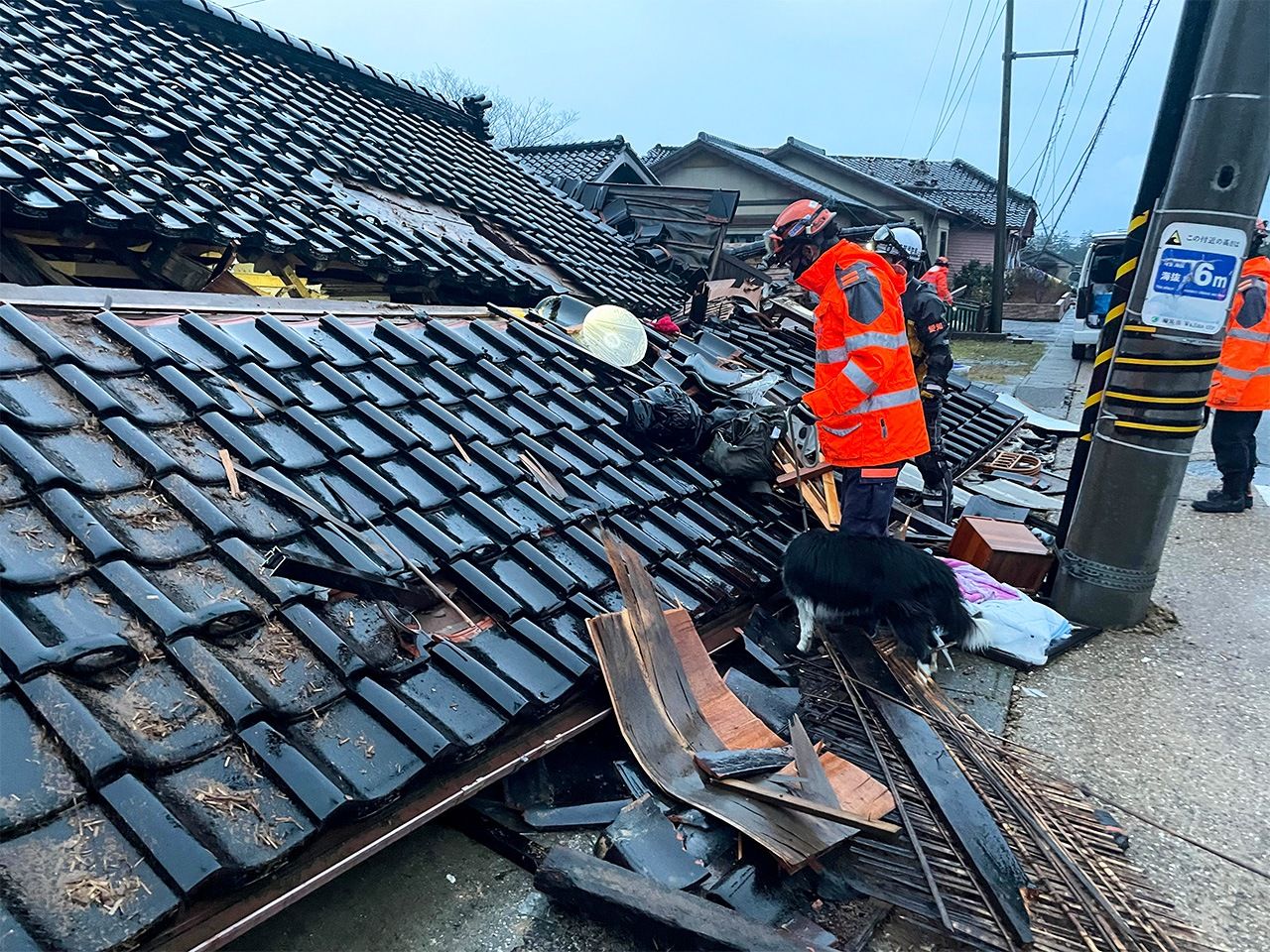
Being briefed on the status of the house by a firefighter at Monzen, Wajima. (Courtesy JRDA Team 7)
Coco ran back and forth to the entrance to the living room, but never barked or wagged his tail horizontally, as he would if he had found someone. In the absence of a response in the living room, I told Coco to “come.” The street we were on appeared to be the community’s main street, and there was a little bit of traffic. Whenever a car went by, someone would call out to warn us. Coco was off his leash, so every time a car went by, I willed him not to jump into the path of the traffic.
Next, we searched the garage that had been crushed under the second story. Pointing to a gap, I instructed my dog to search. Coco entered the dark garage that was full of rubble and dust, moving right and left, and finally going to the back of the space. While I tried to work out where he was by listening for his footsteps, try as I might, I could not hear the sound made by this smallish dog (he weighs just 14 kilograms) walking through the rubble.
If Coco was searching for a survivor, calling him back would interfere with the rescue. Conversely, if I knew that he was not searching for a survivor, I was supposed to call him back and plan our next search. Not being able to see Coco, however, I had no option but to leave things to him.
Presently, our leader instructed us to send the next dog into the building. This is because dogs only have a 10-minute concentration span. “Come,” I yelled. Coco emerged through the external wall at the edge of the garage. While a second dog then searched the living area and a third the area behind the house, neither of them barked.
At 5:11 pm, as it got dark, our leader called off the search.
Interest Sparked in Search and Rescue
Returning to the fire station, I still did not feel tired. Rather, I was relieved that we had finished our search without becoming victims ourselves, and felt strongly that I wanted to assist the search teams the following day too.
This is the same as the way I felt when Coco and I searched for a girl who went missing in 2019 from a campsite in the Yamanashi Prefecture village of Dōshi. While Team 7 only joined that search for one day, we battled heavy rain and strong winds for the entire time. My shoes full of water, I was soaked to the skin and needed to dry off on every break. It was under these circumstances that I spent the whole day searching with Coco. That time, I didn’t feel at all tired while the search was on. It may have been my strong desire to find the girl that prevented me from feeling tired. Coco and I also worked following the July 2021 Mount Izu landslide in Atami, Shizuoka.
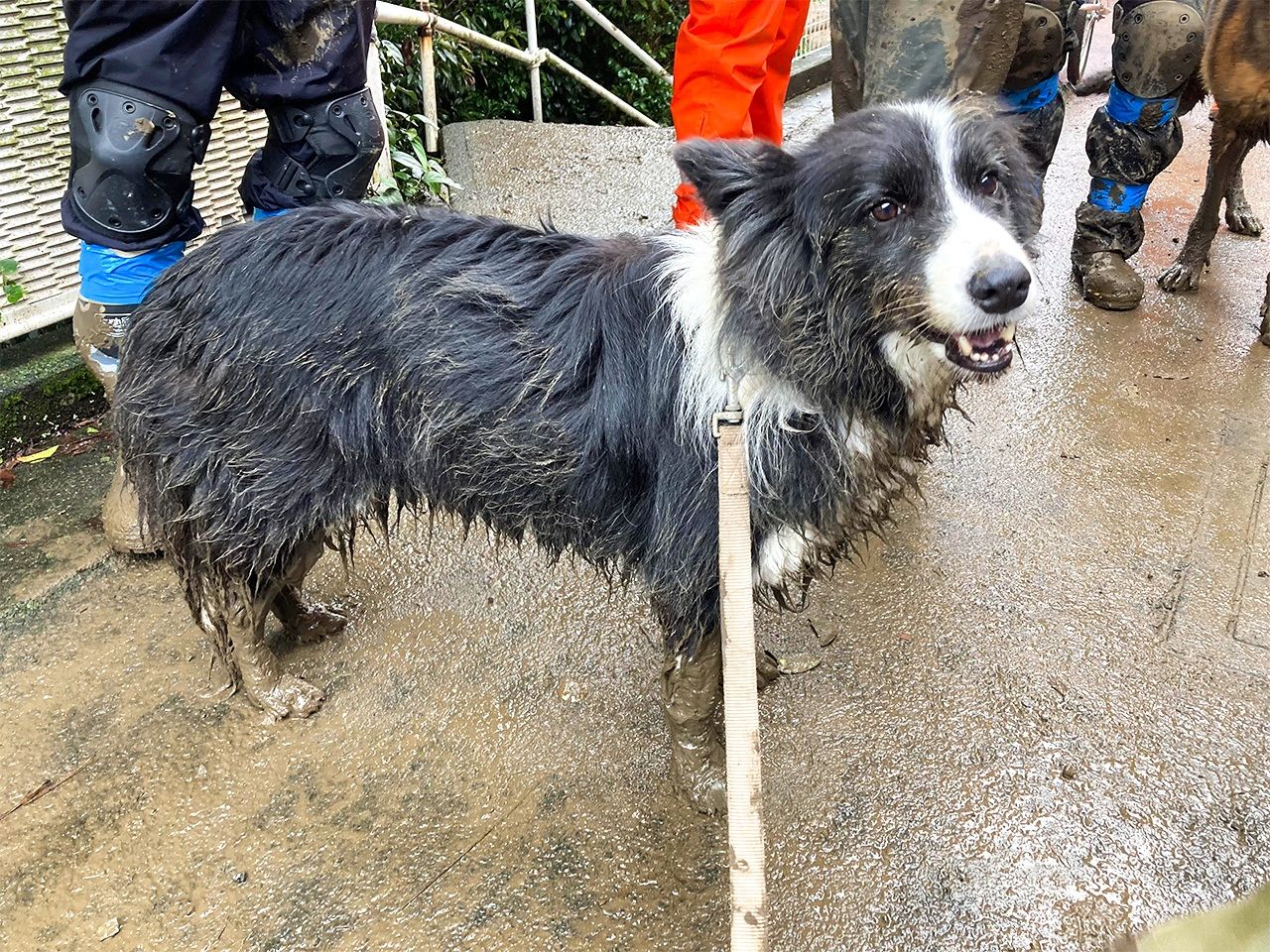
Coco after searching for survivors of the Atami landslide. (Courtesy JRDA Team 7)
It was the 2011 Great East Japan Earthquake and tsunami that inspired me to join the JRDA—the fact that there was nothing I could do for the victims of 3/11 weighed constantly on my mind. I bought a border collie, a breed known for its ability to learn, and hoped to put his abilities to good use.
Search and rescue dogs are generally certified after passing training and certification exams conducted by the JRDA. The certification is valid for two years (this was extended to 3 years during COVID-19), so dogs need to undergo regular certification testing in order to work as search and rescue dogs. Team 7 currently has a total of five search and rescue dogs, including Coco. Coco has passed three consecutive certification exams and is now in his seventh year as a search and rescue dog, making him something of a veteran. After being certified, dogs undergo joint training with local fire departments or similar organizations so that they can be useful in disaster areas. Dogs also undergo routine training a few times a month at the JRDA’s training grounds in Fujimi, Saitama. Around the size of a school sports field, the site contains a mockup of a collapsed house and a mound of rubble two or three stories high. Here, search and rescue dogs and their handlers practice searching for disaster survivors.
At 7:00 pm on January 3, our search over for the day, I had a hot meal to warm myself up. When night fell, however, I was soon freezing again. Of course, I only had to put up with these conditions for two days—those staying in evacuation centers have it much worse. When it was time to go to sleep, I put on a coat and a sleeping bag, but the cold of the car and continuing aftershocks meant I did not get much sleep, waking several times during the night.
Staying Prepared to Serve Disaster-Hit Communities
Just after 6:00 am on January 4, I took Coco for another walk. As we would have to begin searching straight away, I made my preparations and departed the fire station at 7:40, reaching a parking lot near the site in around five minutes. Self-Defense Force personnel were already searching for survivors, and before long we were informed that they were successful. While Coco and the other dogs were not used here, I felt a sense of intense relief. I always feel that it’s a good thing when search and rescue dogs don’t have to be used. In disaster-prone Japan, however, we are not always that lucky.
At 7:50 am, the search was called off. So that my dog could relax, I got him out of his cage and let him play in the remaining snow in the parking lot. Upon our return to the Monzen fire station, we were informed that all dog searches had been called off for the day. We did not know if further searches would be conducted the following day. When I contacted another organization for search and rescue dogs that was waiting near Wajima city hall, they informed me that around Wajima, rescuers had been on standby mode for some time, so it was unlikely that they would be used that day. Hearing this, Team 7 discussed the situation, and decided to leave the site as soon as we were joined by Team Sakura, which had set off later.
Just after 1:40 pm, team Sakura arrived. After briefing them, Team 7 left the Monzen fire station at around 2:30 pm for the long return journey. It was 4:18 am on January 5 when I finally returned home, having dropped off my teammates—a 14-hour journey in total.
Something that really struck me was the way that the people in the evacuation center would bow deeply to us upon seeing our search and rescue dogs. After the Atami landslide, too, locals would stop and bow politely when we passed, wishing us all the best with our search. For Coco and I, doing our best to search for survivors is our way of returning the good wishes of the community.
The day after I returned from Noto, Coco and I did our first one-on-one training session of the year. I’m happy in the knowledge that training together helps us bond.
(Originally published in Japanese. Photos provided by Team 7, part of the Japan Rescue Dog Association. Co-edited by Power News.)
Help Us Train Search and Rescue Dogs
Disasters can strike at any time, and search and rescue dogs and their handlers undergo regular training so that they are always prepared to attend them. You can support initiatives to train search and rescue dogs by making a donation via postal transfer to the account below:
Japan Post Bank account no. 00100-0-176779, NPO Japan Rescue Dog Association
(Write “募金” or “Donation” on the funds transfer slip.)
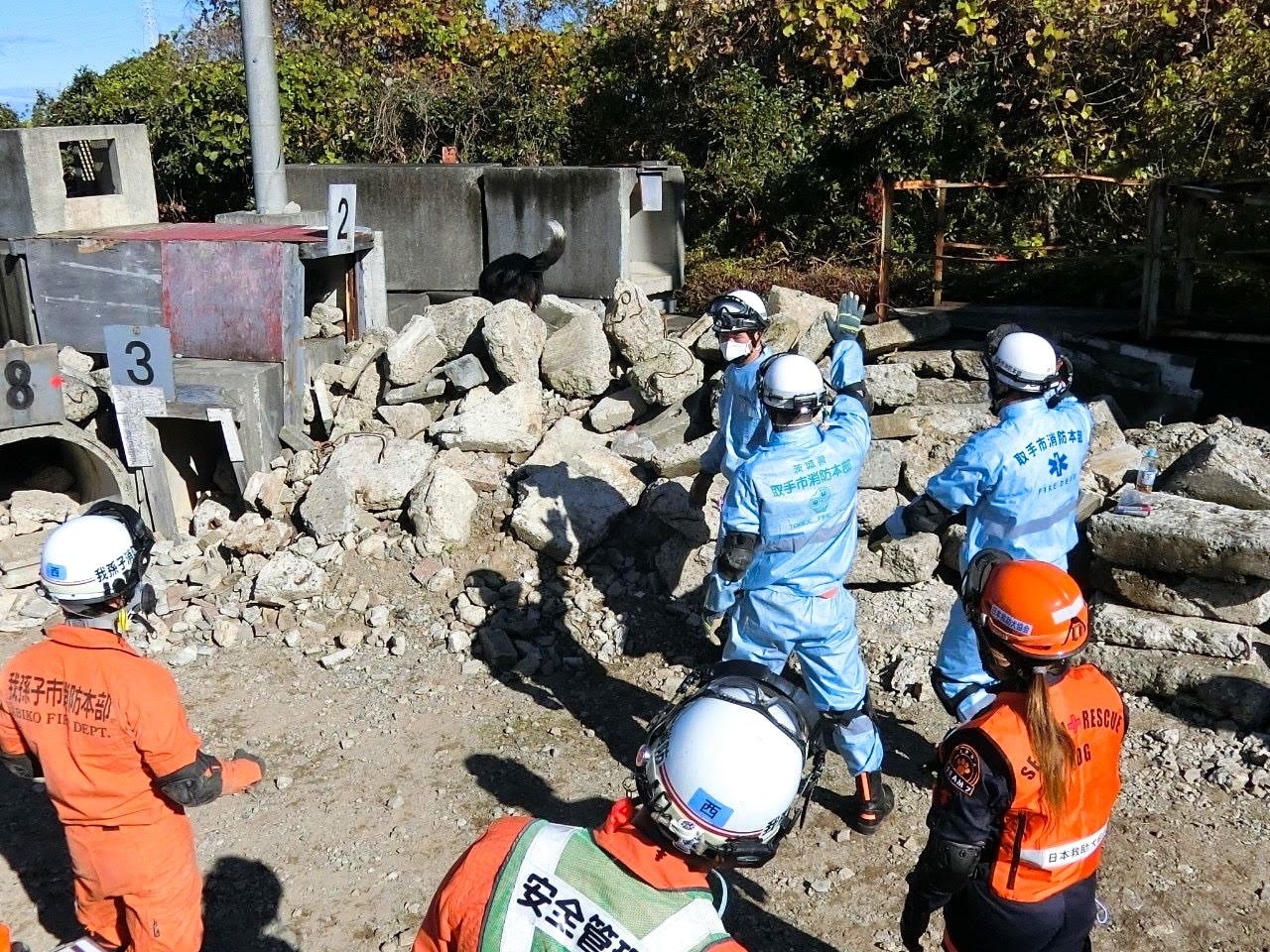
Coco searches in rubble at a 2023 training session conducted in conjunction with local fire departments from Toride, Ibaraki, and Abiko, Chiba. (Courtesy JRDA Team 7)

Training is a way for handlers and their dogs to bond. (Courtesy JRDA Team 7)